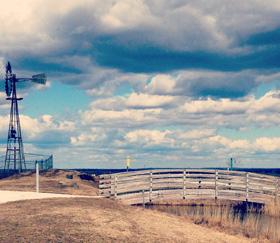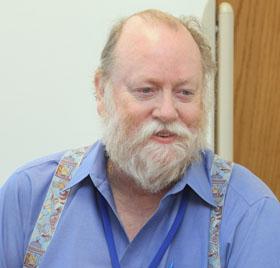
Clouds over Long Island. Conference attendees will discuss how cloud distributions, variations and properties shape weather and climate. [Credit: E. Simon]

Professor William Rossow
International Satellite Cloud Climatology Project gathering to look at the past and future changes of clouds and climate
More than 80 scientists, climatologists and weather experts from across the globe will descend on The City College of New York this month to take part in a conference celebrating the collection of three decades-worth of worldwide satellite observations of the properties, behavior and effects of clouds.
The International Satellite Cloud Climatology Project (ISCCP) will mark its 30th anniversary as a multinational collaboration to collect and analyze satellite data on clouds with its “ISCCP at 30” conference, to take place from April 22-25 in Steinman Lecture Hall at the Grove School of Engineering.
Conference participants will review and assess the latest findings on how cloud distributions, variations and properties shape weather and climate, and will discuss the future of cloud research. The event features fourteen invited presentations and 40 papers contributed by international scientists. The City College of New York and the Cooperative Remote Sensing Science and Technology (CREST) Center - a City University of New York partner of the National Oceanic and Atmospheric Administration – will host the event.
The increase in extreme weather events in recent years has underscored the value and rarity of collecting such long-term global weather data. Far-reaching data analysis projects like the ISCCP help address questions about the workings of the global climate system, its future changes and the role cloud processes play in events like Superstorm Sandy and Hurricanes Irene and Katrina.
Started as a short-term effort to examine raw satellite data on clouds around the world, the ISCCP has become a comprehensive 30-year endeavor to record multiple weather parameters and develop tools to analyze and project various aspects of climate behavior.
“We had a vision born of a purely scientific viewpoint – in order to understand climate we needed to know how clouds work,” said Dr. William B. Rossow, a distinguished professor of electrical engineering at The City College of New York and a member of the CREST Center.
“One of initial goals of the ISCCP was to collect the raw data, calibrate it, format it and reduce it in volume in order to allow others to analyze it. We went on to do our own analysis, making everything available,” he said. “We realized that in order to measure and understand clouds we also had to collect measurements of many other aspects of Earth’s atmosphere and surface, so the whole data collection can have many other uses.”
The ISCCP was established in 1982 as an international research cooperative to systematize the routine collection of climate data around the world. During the initial phase, which ran from 1983–1995, the project gathered information on the properties of clouds in order to evaluate their effects on the Earth’s radiation and study their role in the hydrological cycle – the movement of water between the land, oceans and atmosphere. The ISCCP has since collected datasets that together provide the first long-term, global view of cloud behavior and weather encompassing several El Niño and La Niña cycles.
Professor Rossow has led the ISCCP as head of its global processing center since its inception as the first project of the World Climate Research Program (WCRP). He served as chairman of the working group on data management and analysis for WCRP’s Global Energy and Water Exchanges Radiation Panel. ISCCP has served as the prototype for efforts to establish a global exchange of data and cooperation among multinational agencies to produce tools and algorithms that derive other useful information.
“We have done what we set out to do,” said Professor Rossow. “We can tell you how clouds effect radiation and we are about to complete the first description of the whole water cycle. I think we are really in a position to establish how clouds affect climate, not just statically, but how they feed back on climate change. We are close to that scientific goal.”
The conference is sponsored by the WCRP’s Global Energy and Water Exchanges (GEWEX) project and satellite agencies that participate in data collection. Projects slated for 2013 and beyond by GEWEX will address complex, pressing questions, such as: How do changes in the land-surface and hydrology influence past and future changes in water availability and security? How does a warming world affect climate extremes, especially droughts, floods, and heat waves, and how do land area processes contribute in particular?
Conference Sponsors:
- World Climate Research Program’s Global Energy and Water Exchanges (GEWEX) project
- National Aeronautics and Space Administration (NASA)
- National Oceanic and Atmospheric Administration (NOAA)
- European Meteorological Satellite Organization (EUMETSAT)
- Japan Meteorological Agency (JMA)
- National Institute for Space Research
- Instituto Nacional de Pesquisas Espaciais (INPE)
On the Internet
- ISCCP
- Professor Rossow
- NOAA-CREST
MEDIA CONTACT
Jessa Netting
p: 212.650.5310